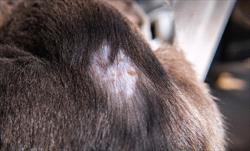Image Courtesy Adobestock

Skin lesions near a grey cat's tail.
Cellulitis is a painful inflammation of the tissue under the skin. In animals, it is generally caused by a bacterial infection that has entered the skin from a cut, open wound, or broken skin from an animal bite.
The most common bacteria causing cellulitis are Staphylococcus and Streptococcus. These bacteria are found in your pets’ environment (in the soil, water, and air), on humans and other animals, and are known opportunists. An open wound is a perfect environment for bacteria to thrive.
You may have heard infections caused by these bacteria referred to as “staph” or “strep.”
It is extremely important to seek your veterinarian’s help as quickly as possible if you suspect a wound has become infected. If left untreated, cellulitis can quickly become very serious, sometimes resulting in the tissues becoming necrotic (tissue death), and can be fatal to your pet in severe cases.
Symptoms
Cellulitis can occur on any part of your dog's or cat’s body where there is a break in the skin, allowing bacteria to enter. For this reason, cellulitis is often the secondary health issue, the first being the wound that breaks the skin. A wound does not always need to be large for bacteria to enter and may go unnoticed until the symptoms of cellulitis appear.
In the affected area, your pet may have:
- sensitivity and pain;
- skin that feels hot to the touch, redness;
- an abscess;
- accumulated pus or green discharge;
- swelling;
- obsessive licking of the area.
The infection may cause your pet to have a fever, refuse to eat, act lethargic, or appear depressed. You may notice an unpleasant odor if there is an abscess or discharge. Often, this odor is the first clue that something is going on with your pet if you are unaware that they have been injured.
Treatment
Your veterinarian will take your pet’s history and examine them for wounds or abscesses. Blood tests and cultures may be needed to determine the type of bacteria in your pet’s body and their overall health.
If an abscess is found and hasn’t already burst, it will be opened, drained, and cleaned, usually under anesthesia or sedation. A piece of sterile tubing, cloth, or other material is often placed into the abscess to allow continued drainage. Stitches may be used to keep this drain in place, and drains are often covered with a bandage.
A lab test may be performed on the fluid from the abscess to identify further the culprit or culprits causing the infection. This is important to ensure that the correct antibiotics are prescribed. Culture results can take several days to return, and a change in antibiotics may be needed. Your pet may have other issues stemming from the original injury, which will be treated as needed.
Your veterinarian will send you home with antibiotics to tackle the infection, possibly anti-inflammatories, and pain medication as needed. Based on culture results, antibiotic therapy can be tailored to your pet’s specific needs, and multiple antibiotics are sometimes needed. Additionally, topical antibiotic ointments are available. You will likely be given a list of aftercare instructions, which may suggest the continued use of warm compresses on the abscess site to encourage drainage. Use a protective e-collar if your pet won’t leave the treated area alone. These cones are available at your veterinary clinic or a pet or feed store.
Be sure to finish the prescription medications as directed.
Sometimes, the drain is not enough, and the abscess fills up again despite your best efforts. Contact your veterinarian if this happens.
Should You Be Concerned About Catching This from Your Pet?
Always wash your hands well before and after treating your pet, and wear gloves if possible. If your immune system is compromised, let your veterinarian know, and pay special attention to hygiene when dealing with your pet’s wound.
Prognosis
Your veterinarian is your best source for information and treatment and for receiving a positive outcome when dealing with cellulitis.
In minor cases and with proper and timely care, your pet should recover without problems.